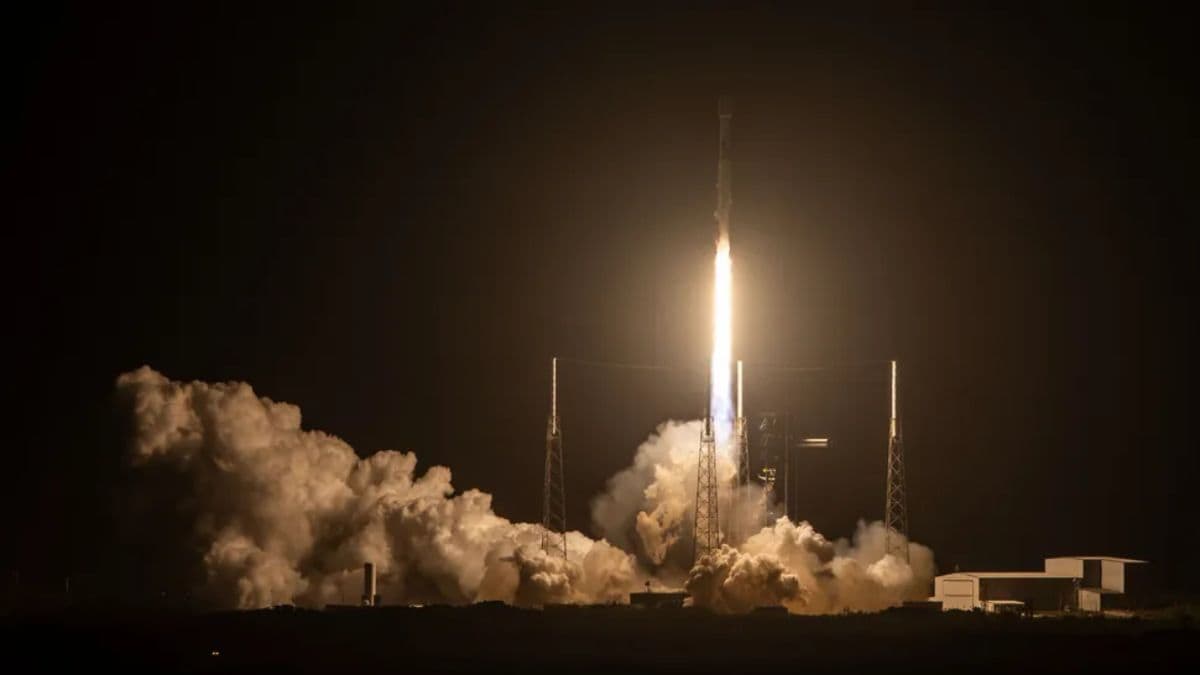SpaceX is set to continue its ambitious Starlink constellation expansion with another launch scheduled from Cape Canaveral Space Force Station. The mission will deploy 28 Starlink V2 Mini Optimized satellites into low Earth orbit, adding to the company’s growing network of internet satellites.
The launch, targeting Tuesday, July 8, 2025, at 8:21 UTC (4:21 a.m. EDT), will lift off from Space Launch Complex 40 (SLC-40). This mission represents SpaceX’s ongoing commitment to building the world’s largest satellite constellation for global broadband internet coverage.
Mission Details and Booster Performance
The Falcon 9 rocket designated for this mission will utilize first stage booster B1077, which is making its 22nd flight. This particular booster has an impressive flight history, having previously launched critical missions including NASA’s Crew-5, GPS III Space Vehicle 06, and a Cygnus spacecraft on the NG-20 mission for Northrop Grumman.
Approximately eight minutes after liftoff, the first stage booster will attempt a precision landing on the droneship ‘A Shortfall of Gravitas,’ positioned in the Atlantic Ocean. This recovery operation continues SpaceX’s revolutionary approach to rocket reusability.
Starlink Constellation Reaches New Milestones
SpaceX has launched nearly 8,500 Starlink satellites since the first operational mission in 2019. Currently, approximately 6,600 satellites remain in operational orbit, according to statistics maintained by astronomer Jonathan McDowell.
The company has maintained an aggressive launch schedule throughout 2025. As of early July, SpaceX has already launched over 1,500 Starlink satellites across 61 missions this year alone, accounting for the vast majority of the company’s 83 Falcon 9 missions.
This rapid deployment pace underscores SpaceX’s determination to achieve global broadband coverage through its satellite constellation.
Breaking Records and Setting New Standards
The Starlink program has been instrumental in SpaceX achieving several industry milestones. On July 2, 2025, the company celebrated its 500th Falcon 9 rocket launch, with the mission deploying 27 Starlink satellites and featuring booster B1067 on its record-breaking 29th flight.
This achievement highlights the success of SpaceX’s reusability model, which has fundamentally transformed the economics of space access. The company has successfully landed and reused first stage boosters 472 times as of early July 2025.
Competition and Future Developments
While SpaceX dominates the satellite internet market, competition is emerging. Amazon’s Project Kuiper aims to deploy 3,232 satellites by 2028, though it significantly trails SpaceX’s current deployment.
Looking ahead, SpaceX founder Elon Musk has announced plans for next-generation V3 Starlink satellites. These larger satellites will operate at approximately 350km altitude instead of the current 550km, potentially reducing latency below 20 milliseconds.
The V3 satellites are expected to begin deployment via Starship launches by the end of 2025, marking another significant evolution in satellite internet technology.
Launch Viewing and Weather Conditions
For space enthusiasts planning to watch the launch, the 45th Weather Squadron typically provides detailed forecasts for launch windows. The pre-dawn timing offers spectacular viewing opportunities, with the rocket’s exhaust plume creating dramatic visual displays against the dark sky.
Cape Canaveral Space Force Station’s Space Launch Complex 40 has become the workhorse pad for SpaceX’s Starlink missions. This upcoming launch will mark another milestone for the historic launch site.

Impact on Global Connectivity
The Starlink constellation continues to expand its coverage, providing high-speed internet access to remote and underserved areas worldwide. Each launch of 28 satellites incrementally improves the network’s capacity and coverage area.
With over 6,600 operational satellites currently in orbit, Starlink has become the world’s largest satellite constellation, fundamentally changing how global internet connectivity is delivered.
As SpaceX maintains its ambitious launch schedule, the company edges closer to its goal of providing truly global broadband coverage, potentially transforming internet access for millions of people worldwide.
Looking Forward
This upcoming mission represents not just another routine launch, but a continuation of SpaceX’s revolutionary approach to space operations. The combination of rapid launch cadence, booster reusability, and mass satellite production has created a new paradigm in the space industry.
As the Starlink constellation grows with each successful launch, SpaceX continues to demonstrate that regular, cost-effective access to space is not just possible but has become routine. The upcoming launch of 28 Starlink satellites from Cape Canaveral adds another chapter to this ongoing transformation of space operations.














